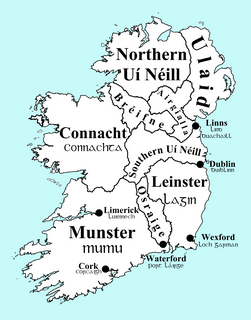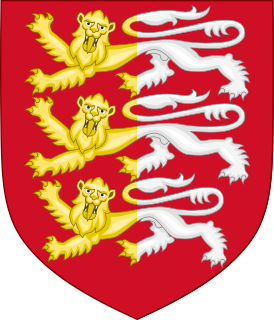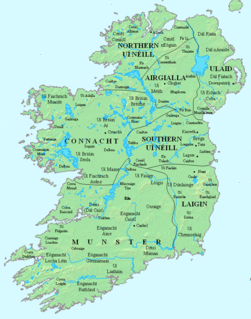 W
WThe Kings of Ailech were the over-kings of the medieval Irish province of Ailech in north-western Ireland. It encompassed the territories of the Cenél nEógain and Cenél Conaill. After the battle of Cloítech in 789 its kings have been exclusively from the Cenél nEógain. The royal fort for Ailech was the Grianan of Aileach, a hillfort on top of Greenan Mountain in modern-day County Donegal, Republic of Ireland.
 W
WDevaney, Devany, and O'Devaney, is a surname derived from the Irish Ó/Mac Duibheamhna, meaning "descendants/son of Dubheamhna". They are cited by O'Dugan as being chiefs of Kinelawley in the over-kingdom of Ulaid, now known as Clanawley in present-day County Down, Northern Ireland.
 W
WDoolan is a surname of Irish origin. They were chiefs of the Clan Breasail Mac Duileachain in the Ulaid sub-kingdom of Dál Fiatach, specifically located in what became the barony of Castlereagh.
 W
WDowney is an Irish surname that means in English “belonging to a fort”. The name is found from ancient times in areas of Ireland’s modern County Galway, southwest Cork, Kerry, Limerick, Ulster and Leinster and is believed to be the surname of three distinct families. In Ulster, Downey were the chiefs of the Ulaid petty-kingdom of Cinel Amhalgaidh, now known in the Anglicised form as Clanawley in County Down, Northern Ireland.
 W
WThe FitzGerald / FitzMaurice dynasty is a Cambro-Norman and Anglo-Norman, and later Hiberno-Norman, aristocratic dynasty. They have been peers of Ireland since at least the 13th century, and are described in the Annals of the Four Masters as being "more Irish than the Irish themselves" or Galls, due to assimilation with the native Gaelic aristocratic and popular culture. The dynasty has also been referred to as the Geraldines. They achieved power through the conquest of large swathes of Irish territory by the sons and grandsons of Gerald of Windsor. Gerald of Windsor was a Norman castellan in Wales, and he is the male progenitor of the FitzMaurice and FitzGerald dynasty.
 W
WThe O'Kennedy family, sometimes simply Kennedy, were an Irish royal dynasty, a sept of the Dál gCais, founded in the Middle Ages who were Kings of Ormond. Their founder was the nephew of High King Brian Boru (1002–1014).
 W
WMac Giolla Phádraig (pronunciation) is a native Irish dynastic surname which translates into English as "Son of the Devotee of (St.) Patrick". In the medieval period, the Mac Giolla Phádraigs were hereditary kings of Osraige; today, the name is commonly translated to "Fitzpatrick".
 W
WMacCarthy, also spelled Macarthy, McCarthy or McCarty, is a Celtic/Gaelic Irish clan originating from Munster, an area they ruled during the Middle Ages. It was divided into several great branches; the MacCarthy Reagh, MacCarthy of Muskerry, and MacCarthy of Duhallow dynasties were the three most important of these, after the central or MacCarthy Mór line.
 W
WMcGee or McKee is an English language surname of Irish origin. The surname McGee was first found in along the border of counties Donegal and Tyrone Tír Eoghain, the ancient territory of the O'Neills, now in the Province of Ulster, central Northern Ireland, where they are thought to be descended from the Colla Uais. McGee was later a chieftain clan of the Ulaid, of which their territory corresponded to the Islandmagee peninsula in modern-day County Antrim, Northern Ireland. It is also anglicised as "McCoy".
 W
WMcGowan is an Irish surname. It is an Anglicization of the Irish Mac Gabhann & Scottish surname Mac Gobhann. Belonging to the Uí Echach Cobo, located in modern-day County Down, Northern Ireland, they produced several over-kings of Ulaid. By the late 12th century, the English had expelled the McGowans to Tír Chonaill in modern-day County Donegal, Republic of Ireland.
 W
WThe O'Conor Don Family, are an Irish noble house and were one of the most influential and distinguished royal houses in Ireland. The O'Conor family held the throne of the Kingdom of Connacht up until 1475. Having ruled it on and off since 967, they ruled continuously from 1102 to 1475. However the O'Conor parent house the Uí Briúin and Síol Muireadaigh ruled Connacht on many occasions but not continuously between 482 and 956. The house of O'Conor also produced two High Kings of Ireland, Tairrdelbach Ua Conchobair and his son Ruaidrí Ua Conchobair the Last High King of Ireland. The family seat is Clonalis House outside Castlerea in County Roscommon.
 W
WThe Ó h-Anluain family was an agnatic extended family comprising one of a string of dynasts along the Ulster-Leinster border. Depending on the advantage to the sept, the named leader—The O'Hanlon—supported either the Earl of Tyrone or authorities within the English Pale. During the 15th century, ties were close with the famed Earls of Kildare. Frequently, members of the sept would be on either side of a rebellion. Some would be outlawed; others pardoned; some ending up on the winning side.
 W
WThe O'Brien dynasty is a royal and noble house founded in the 10th century by Brian Boru of the Dál gCais or Dalcassians. After becoming King of Munster, through conquest he established himself as Ard Rí na hÉireann. Brian's descendants thus carried the name Ó Briain, continuing to rule the Kingdom of Munster until the 12th century where their territory had shrunk to the Kingdom of Thomond which they would hold for just under five centuries.
 W
WThe O'Neill dynasty is a lineage ultimately all of Irish Gaelic origin, that held prominent positions and titles in Ireland and elsewhere. As Kings of Cenél nEógain, they are historically the most prominent family of the Northern Uí Néill, along with the O'Donnell and O'Doherty. The O'Neill's hold that their ancestors were kings of Ailech during the Early Middle Ages, as descendants of Niall of the Nine Hostages.
 W
WThe kings of Osraige reigned over the medieval Irish kingdom of Osraige from the first or second century AD until the late twelfth century. Osraige was a semi-provincial kingdom in south-east Ireland which disappeared following the Norman Invasion of Ireland. A number of important royal Ossorian genealogies are preserved, particularly MS Rawlinson B502, which traces the medieval Mac Giolla Phádraig dynasty back through Óengus Osrithe, who supposedly flourished in the first or second century. and one in the Book of Leinster. Recent analysis of ninth and tenth century regnal succession in Osraige has suggested that in peaceful times, kingship passed primarily from eldest to youngest brother, before crossing generations and passing to sons and nephews.
 W
WThe Sliocht Cormaic of Dunguile, otherwise known as the MacCarthys of Srugrena Abbey, or the Srugrena sept, as well as the Trant McCarthys, are a sept of the MacCarthy Mór dynasty, the Kings of Desmond. They are descendants of a younger son, Cormac of Dunguile, of Tadhg na Mainistreach Mac Carthaigh Mór, King of Desmond. The line of the later kings of Desmond, to Donal IX MacCarthy Mór has long been extinct.
 W
WUí Fhiachrach Aidhne was a kingdom located in what is now the south of County Galway.